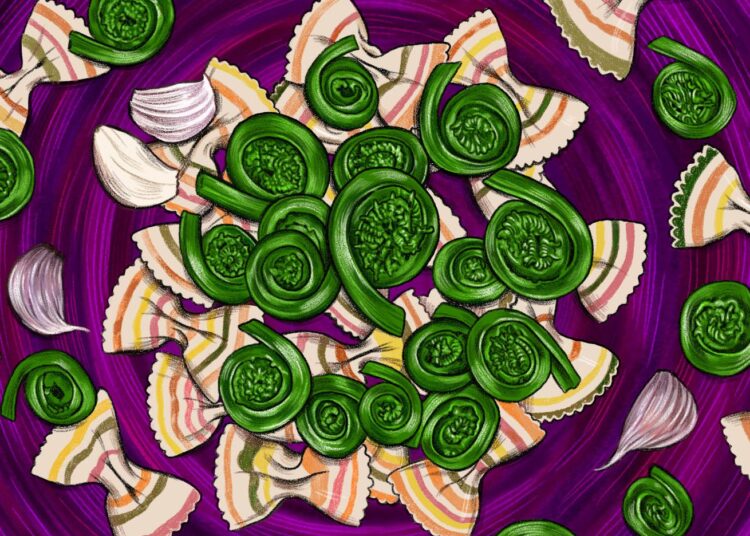Dilek Baykara
There’s a lot you can do! Just don’t eat them raw.
Whether they’re growing in a forest or being sold at a farmers market, fiddlehead ferns are natural head-turners. While their visual appeal can be chalked up to their novelty — bright green and tightly coiled, they look like they’d be right at home in a UFO’s window box — the explanation is much more complex. Fiddlehead ferns are a natural expression of the golden ratio, a geometric proportion based on a sequence of numbers identified by the mathematician Leonardo Bonacci (known today, like all icons, by a single, more famous name: Fibonacci). What does that have to do with dinner? Long story short, we’re scientifically inclined to appreciate the spiraling beauty of a fiddlehead fern, so it’s totally understandable if you happen to find yourself in a kitchen with an overabundance of them. When the enchantment wears off and reality sets in, foragers and fiddlehead aficionados Ashley Rodriguez and Chrissy Tracey have advice for what to do.
When exactly you’ll see fiddlehead ferns pop up in your local environment depends on a variety of factors, including whether you live on the West Coast (like Rodriguez), the East Coast (like Tracey), or somewhere in between, but these springy delicacies are usually at their peak in April and May. The variety available also varies by region.
“The ferns that you typically see in culinary applications are referred to as ostrich ferns (Matteuccia struthiopteris),” explains Tracey. “Ostrich ferns are distinct because the stalk is smooth with brown, papery scales and a deep, U-shaped groove along the inner stem.”
Rodriguez notes that in the Pacific Northwest it is also possible to come across the Bracken fern (Pteridium aquilinum) and lady fern (Athyrium filix-femina). “As with anything you forage” from wild spaces, Rodriguez says, “make sure you can identify the species with 100-percent accuracy.” This is crucial because some ferns are considered to be mildly toxic. For your personal health, as well as the wellbeing of the ecosystem, “forage in an area free from contaminants and only take a small amount in one area so the plant can continue to flourish,” Rodriguez says.
However you procure your fiddleheads, never eat them raw, as in this form “they can cause food poisoning and gastric distress,” Tracey explains. “You should always remove the brown papery husks while foraging, followed by washing them thoroughly, and finally, boiling them for at least 10 minutes” before you prepare them. If you’re not going to eat them right away, they can be stored fresh in the fridge for about a week.
Though fiddleheads may not look like anything ordinarily stocked in your kitchen, they share similar qualities with some more familiar springtime vegetables. “Their flavor is reminiscent of asparagus, peas, and green beans, though distinctly unique,” Tracey says. “They tend to be tender and crisp in texture, similar to a broccolini stem, and are often referred to as snappy.”
“They are such a lovely green base and can be used with so many different flavors and spices,” Rodriguez adds. “I tend to follow the old adage ‘what grows together goes together,’ so I often pair them with lots of herbs and whatever else is coming into season.”
If you’re cooking with ferns for the first time, both foragers recommend keeping things simple by sauteing them in butter or olive oil with lemon zest, salt, and pepper.
“Sometimes I’ll throw white wine in the mix, which gives them a bit of a lift,” says Tracey, who also suggests adding “loads” of garlic. “I developed a dish that combines all of those elements, but in a pasta dish with farfalle and fresh peas. A little parmesan over the top goes a long way and it makes an absolutely fabulous meal.”
In another Italian-inspired preparation, both Rodriguez and Tracey advocate for tossing this mixture over risotto, noting that it also works well spread on top of pizza or focaccia.
Once you’re ready to do more experimenting — or, if you have a few too many fiddleheads to eat in a week — it’s time to try pickling them. “They are such a fun thing to pickle as their shape is so delightful and the texture holds up very well,” Rodriguez says; she enjoys adding them to a cheese board as a crunchy, vinegary contrast to the rich, creamy dairy.
If you’re craving something spicy, you can try making tempura fiddleheads, as Tracey does; lightly battered and fried, they’re great accompanied by chile crisp, soy sauce, and rice vinegar.
When all else fails, these ferns, like most edible plants, make a great addition to a plate of scrambled eggs, or can be folded into a clean-out-the-fridge medley of roasted vegetables. Despite their flamboyant, otherworldly appearance, fiddleheads are as approachable and down-to-earth as any other springtime greens — and a lot less fussy than the ramps and morels that tend to take center stage during this season.
Elena Valeriote is a writer of stories about food, farming, culture, and travel that explore the connection between people and place. Her work has appeared in publications including Gastro Obscura, Modern Farmer, and Life & Thyme.
Dilek Baykara is a Turkish-American illustrator, print designer, and adventurous gastronome living in Brooklyn, New York.














